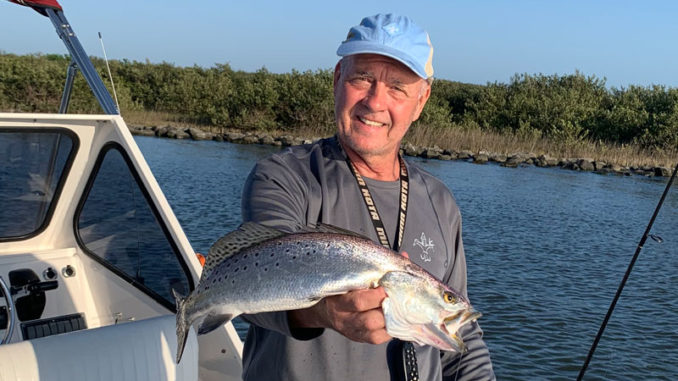
LWFC receives report that trout numbers continue decline
Anglers enjoying recreational fishing for Louisiana’s spotted seatrout, most commonly called speckled trout, may face changing requirements on length and daily bag limits.
Jason Adriance, marine fisheries biologist for Louisiana Department of Wildlife and Fisheries, spoke to commissioners about the requirements Thursday, Sept. 1, at their regular monthly meeting.
Adriance told commissioners in their March meeting, Fin Fish Task Force members endorsed a 13 1/2-inch minimum length and 15-fish bag limit recommendation.
“(Spotted seatrout) stock is still overfished,” Adriance warned LWFC members Thursday.
According to the 2021 LDWF stock assessment, Louisiana’s speckled trout stock has been overfished since 2016. Adriance explained overfishing of stock happens when the spawning biomass is too low. Overfishing occurs when anglers remove too many out of the population to replenish the stock.
“We’re still at a point were we feel we need management actions,” Adriance said.
Recreational catches of spotted seatrout have taken “a little bump” upwards from last year, according to the biologist. So far this year, anglers have harvested on average two fish and discarded on average two spotted seatrout during fishing trips. Ages of the female fish caught were two years old with only 15 percent of fish older than three years.
“There has been slightly more harvested,” Andriance said. He also added the 1.8 million angler trips so far this year is down from previous years.
What might happen next
What can anglers expect if new regulations are officially proposed?
According to LDWF, a notice of intent (NOI) will first be brought before the Commission at a regular monthly meeting. The Commission will take public input on the NOI during a monthly meeting and possibly vote whether to approve the NOI as is or with modifications based on discussion and public input. Once the NOI is approved, public comment will be accepted for approximately 40-45 days. LDWF will also hold public meetings and publish a press release.
After the public comment period has closed, the NOI and public comments are transmitted to and reviewed by the Senate Committee on Natural Resources and the House Committee on Natural Resources and Environment as part of the Legislative Oversight process. During the Legislative Oversight process, these committees have 30 days to consider a hearing. After this process is complete, the NOI will go back for final commission consideration. Final rule becomes effective when it is published in the Louisiana Register.
Menhaden reporting
In other action, commercial menhaden (pogie) fisheries may have to report daily catch data directly to LDWF instead of sending information to the National Oceanic and Atmospheric Administration (NOAA). LWFC Commissioners passed a NOI that would require the monthly reporting.
The proposed rule is mandated by Act 759 of the 2022 Regular Session of the Louisiana Legislature.
“That proposed rule requires electronic data monthly from the industry beginning May 2023,” Adriance said. “That data is for each set. Act 759 requires the LWF Commission to enact regulations that mandate detailed reporting at the individual set level by the commercial menhaden reduction fishery. The data collection would begin with the 2023 commercial menhaden season.
Under the rules, data would be sent to the Senate Committee on Natural Resources and the House Committee on Natural Resources and the Environment beginning on February 10, 2024, according to the NOI. The only difference in the new requirement is that LDWF will receive the data directly. In the past, NOAA received the data and then would send LDWF data, according to Adriance.
Ben Landry of Omega Protein spoke to LDF Commissioners in support of the NOI. “We support this NOI. It is very similar to the captain’s daily report that we have been providing to NOAA for 50 years,” Landry said.
That isn’t enough, according to sports fishing interests, who say the pogie boats should be moved further offshore to prevent damage to the coast’s fragile ecosystem and to reduce thousands of pounds of “bycatch” of speckled trout and redfish which are killed and go to waste. Changes in reporting isn’t expected to make this controversy go away.
Other states are taking big steps
Louisiana isn’t the only state having issues with menhaden fishing. Some states are taking much harsher steps in preserving menhaden numbers. Maine’s Department of Marine Resources announced an end to menhaden commercial fishery this season on Aug. 28.
It was anticipated that an increase in effort would occur within Maine’s menhaden fishery for the 2022 season due to recent legislative action to develop a limited entry license for 2023 with a landing requirement of 25,000 pounds. However, Maine has landed 170 percent more pounds of menhaden in 2022 than in 2021, and 250 percent more pounds in 2022 than in 2020. To date, that is 15.8 million pounds under the small-scale fishery.”
According to a news release from the Maine Department, the Interstate Fishery Management Plan for Atlantic menhaden allows for Maine to harvest roughly 2.2 million pounds. Maine fisheries experts determined that it is necessary to take emergency action to end the commercial fishing season to prevent unusual damage to the menhaden resource by exceeding available quota.


